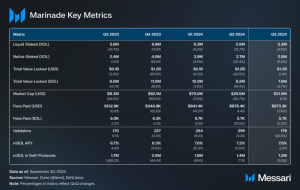Key Insights
- Covalent offers a Unified API that allows developers to reuse queries across multiple blockchains.
- The project has provided data to many crypto companies with a wide set of use cases, namely Consensys (investor dashboards), CoinGecko (on-chain DEX data), rotki (taxation tools), NFTX (NFT galleries), and Rainbow (consumer wallet).
- As of October 2022, Covalent supports 26 blockchain mainnets and plans to support over 50 by 2023.
- Covalent’s Block Specimen standard promises to make blockchain data composable and reusable outside of the execution environment.
- While The Graph is currently most suitable for projects that require specialized datasets, Covalent is currently best suited to serve applications that require general-purpose, widely applicable data.
Introduction
Though blockchain data is public and accessible, it’s often hard to get. It becomes even more complicated when applications like wallets and NFT marketplaces require data from multiple blockchains with varying output formats. Covalent built a protocol that standardizes data from over 25 blockchains; its Unified API allows builders to reuse queries across its supported networks.
APIs transfer data between two parties: a client and a server. Using APIs, servers maintain control over their systems and respond to client requests. Users, like application developers or analytics firms, pull data from APIs while the data providers maintain ownership. Though many companies have built server-side infrastructure to provide access to blockchain data, most have stopped at the RPC layer. These conventional approaches tend to fetch only surface-level data formatted to the requested blockchain.
Covalent’s protocol goes deeper than conventional approaches: it extracts data from various blockchains, uploads that data to a storage instance, indexes and transforms the stored data object, and loads the data into local data warehouses queried by API users. Throughout the process, it sends proofs to the Moonbeam network to authenticate the work completed at each step. In short, Covalent cryptographically secures and standardizes all of the extracted blockchain data so developers can query from any chain in a unified way, hence, the Unified API.
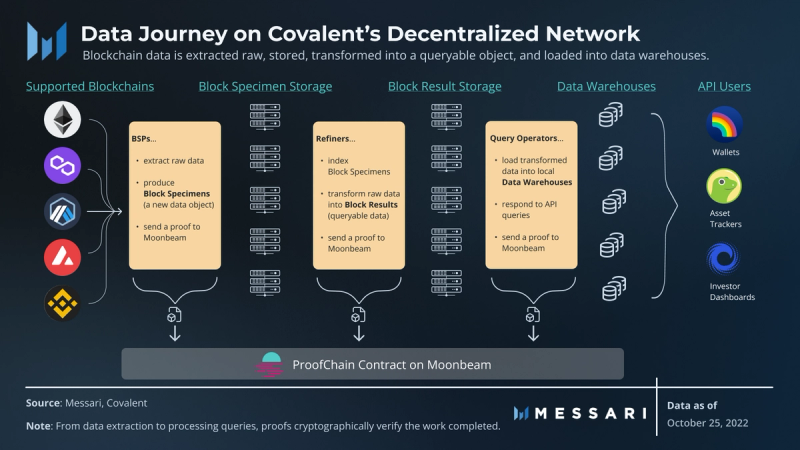
Overview of Covalent
Covalent’s Progressive Decentralization
Covalent began as a hackathon project in 2017. Since its inception, it has maintained its goal of building an indexing engine capable of serving deep metrics from blockchains. Examples of these deep metrics would include getting tokenholders as of any block height or getting log events emitted by a certain smart contract address.
In October 2020, Covalent only supported Ethereum. But as of October 2022, Covalent supports a growing list of over 25 blockchain mainnets that API users can query. Additionally, Covalent recently became the first blockchain data provider to index app chains. Co-Founder/CEO Ganesh Swami told Messari that Covalent will announce support for additional blockchains as early as Q1 2023.
Before embarking on a path of progressive decentralization, Covalent sought product-market fit for its indexing engine. In addition to the interested parties backing Covalent, the project earned revenue from clients in the crypto industry such as ConsenSys, CoinGecko, and 0x Labs. Covalent told Messari that its years of business activity serving enterprise clients confirmed market demand, laying the foundation for the type of data that can be queried from its Unified API.
Network Participants
Covalent’s decentralized protocol will have multiple network participants, called “operators.” Currently, only one of the network operator roles is live, that of the Block Specimen Producer (BSP). As of October 2022, Covalent has 12 BSPs; notable ones include Chorus One, Woodstock, StakeWithUs, and the University of Calgary. However, this role is still permissioned as Covalent continues to decentralize.
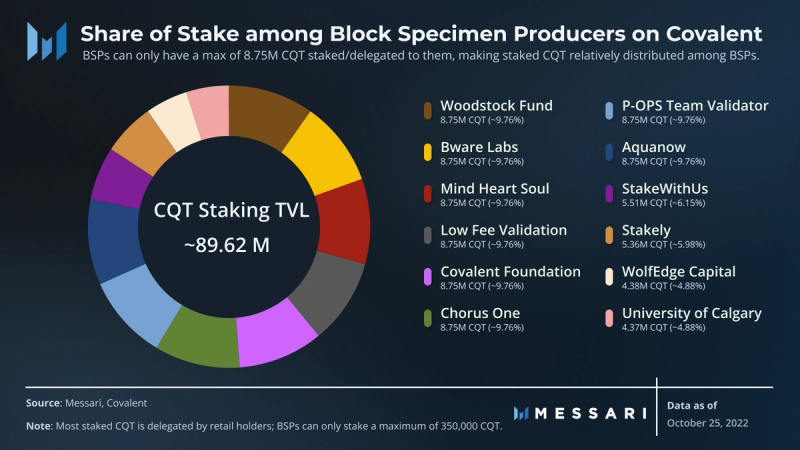
The Block Specimen Producer extracts raw blockchain data and creates a data object called a Block Specimen. The BSP standard promises to make blockchain data composable and reusable outside of the execution environment. The Block Specimen Producer then uploads the Block Specimen to a storage instance, creates a hash (or proof) of the stored Block Specimen, and publishes the proof to Covalent’s ProofChain smart contract on Moonbeam. Once the proof is on Moonbeam, other network nodes can validate the BSP’s work.
As of October 2022, the other network operator roles that have yet to go live include Refiners, Query Operators, Auditors, and Storage Operators.
- Refiners take Block Specimens from storage, transform the raw data into a queryable data object called a Block Result, and then publish a proof to validate that work.
- Before responding to API queries, Query Operators load the transformed data into local data warehouses.
- Each network operator gets paid for performing their roles after Auditors confirm each proof for a particular epoch. Before payment, a group of Auditors is randomly chosen from the total set of network operators to act as Auditors during the audited epoch.
- When Block Specimen Producers upload data to a storage instance, they can either run that instance locally or pay Storage Operators to run it. Storage Operators are expected to increase the data availability of proofs by loading them through IPFS and storing them locally.
Covalent currently manages these roles as it works to open them up to entities eager to participate.
Covalent told Messari that it plans for all of its network operator roles to be live by 2024. As Covalent decentralizes its protocol, the overall effectiveness of its decentralization will be revealed in the growth and activity of network participants like Block Specimen Producers, Refiners, and Query Operators.
CQT Tokenomics, Investors, & Utility
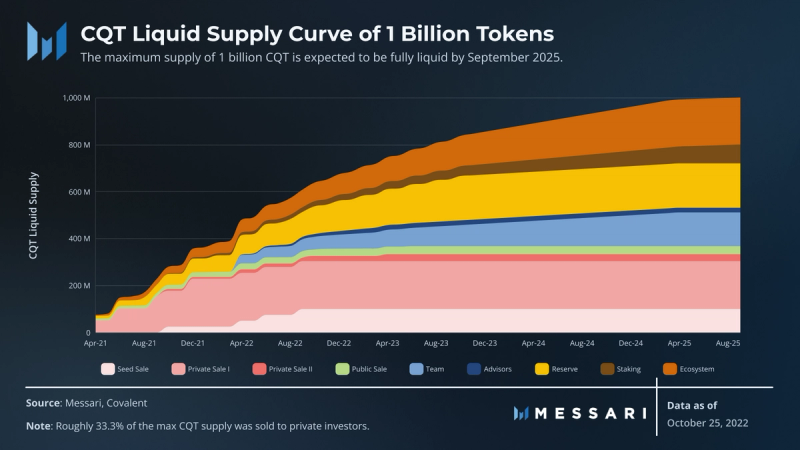
Covalent raised roughly $15.71 million from one private seed sale, two strategic private sales, and one public sale. Private sale participants from sales in 2020 include Woodstock Fund, 1kx Capital, Mechanism Capital, AU21 Capital, Brilliance Ventures, TRG Capital, Alameda Research, and CoinGecko. Private sale participants from sales in 2021 include Hashed, Binance Labs, Coinbase Ventures, Delphi Ventures, Hypersphere Ventures, and the entities behind Avalanche, NEAR Protocol, Elrond, and Moonbeam.
The Covalent Query Token (CQT) was launched on Ethereum with a 1 billion maximum supply with varying vesting schedules. Of this supply, roughly 33.3% (333 million CQT) was allocated to the private sale participants mentioned above. The Team and Advisors were allocated roughly 16.4% (164 million CQT) of the max supply. The remaining allocations (Public Sale, Staking, Reserves, and Ecosystem) accounted for roughly 50.3% (503 million CQT) of the max supply.
CQT is a governance token also used for staking and settling payments with network operators. As Covalent decentralizes, governance is still in its early stages and requires manual intervention from the team. While community members generate improvement proposals that start on the forums and Discord, the team decides if the proposal should move to Snapshot for a final, off-chain vote based on feedback and a rough consensus. Passed proposals are then implemented by the Covalent team. As of October 2022, Covalent has held three votes on Snapshot, with the most recent being from March 2022.
While governance uses CQT on Ethereum, staking and payment settlement are conducted with CQT bridged to Moonbeam. CQT follows a Stake-for-Access (SFA) token model that requires network operators to stake CQT to perform network duties and subsequently get paid. Network operators stake CQT with the risk of their stake being slashed for negligence or malicious behavior — though slashing has yet to go live as of October 2022.
CQT that is staked by network operators cannot be sold for at least 180 days due to the unbonding period. CQT’s value will be driven by a mechanism that connects API demand with the network’s data supply. Beginning in Q1 2023, payments will be made in USD-denominated stablecoins which will be used to market buy CQT to reward operators. The unbonding period and market buy function may benefit the asset price due to the decreased sell pressure and increased buy pressure. However, the liabilities and infrastructure overhead is likely to be paid in another currency, which could present a challenge for network operators by creating sell pressure on the newly rewarded CQT.
Holders that choose not to run operator nodes can delegate CQT to network operators. In return, they earn a variable yield based on the amount of CQT staked and the commission taken by the network operator. The yield comes from inflationary staking rewards (used as an incentive to bootstrap network operator activity) that will supplement network rewards for up to four years. Given sustained activity, rewards will then come from payments made to the protocol for querying Covalent’s API.
Nomad Bridge Hack
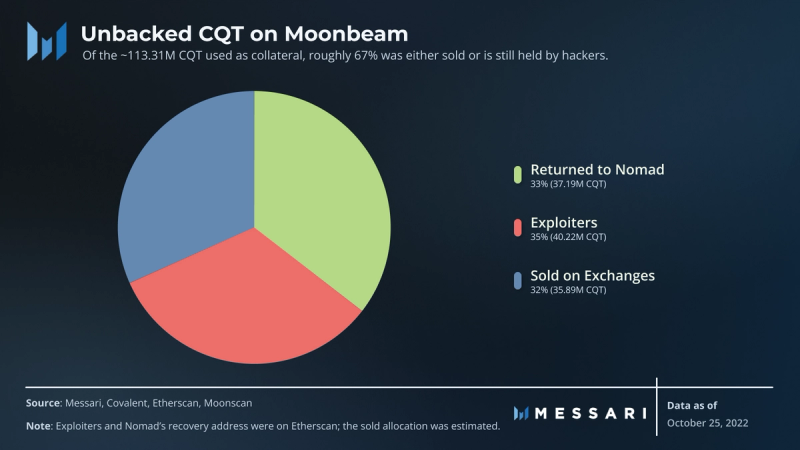
On Aug. 1, 2022, Nomad Bridge experienced a hack that resulted in the loss of $190 million in total, which included 113.31 million CQT tokens (~11.33% of the max CQT supply). Since a “white hat bounty” was placed on the stolen funds, roughly 37.19 million CQT has been returned. As of October 2022, Nomad and Covalent continue to work toward reopening the bridge and recovering funds.
This hack affected network operators and anyone that bridged CQT to Moonbeam. Given Covalent’s partnership with Nomad, all CQT on Moonbeam became unbacked because all ERC-20 CQT collateral was held in Nomad’s bridge smart contracts. Covalent explained to Messari that, although Nomad’s bridge remains shut down, Block Specimen Producers continue to operate network nodes.
Notable Competitors
It’s tempting to see the keyword “API” and want to compare Covalent to any competitors offering access to on-chain data via APIs. However, most entities with API products only gather data at the RPC layer. Stopping at this layer puts the burden of querying and standardizing different blockchains’ data on developer teams.
Potential Complements
Because Covalent offers a Unified API, providers like Infura and Alchemy can be seen as complements of Covalent. Covalent told Messari that its network operators actually pull data from sources like Infura and CoinGecko. It then packages the data so it can be pulled from Covalent’s Unified API. This flexibility becomes important in a multichain world where data retrieved from a blockchain at the RPC layer can be different from other chains’ data.
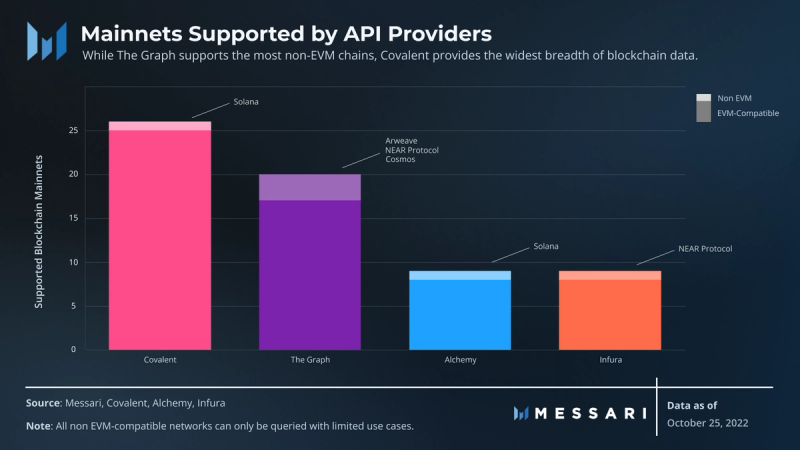
As displayed by the chart above, As of October 2022, Covalent supports 26 blockchain mainnets while Alchemy supports 9, Infura supports 9, and The Graph supports 20. Other protocols require additional steps when calling data. For example, queries for data to support a wallet application may differ depending on the blockchain. Additionally, the output’s format may differ, requiring multiple iterations of data cleaning. Using Covalent’s Unified API, queried data only needs to be cleaned once to fit the desired application, no matter which blockchain the data came from.
The Graph
While Alchemy and Infura maintain centralized structures, The Graph is an indexing protocol with network participants that are incentivized to perform key operational tasks for rewards. Compared to Covalent, all network participant roles are live. The Graph is expected to achieve full decentralization as it sunsets its hosted service by the end of Q1 2023.
However, Covalent and The Graph do not compete directly as market indexers. Applications that use Covalent tend to require general-purpose, widely applicable data. They tend not to need the highly specialized, diverse datasets that subgraph developers build. Applications in sectors such as wallets, NFT marketplaces, and taxation services would be more likely to use Covalent. Meanwhile, a larger scope of applications may be inclined to use The Graph if they rely on detailed niche data. In curating the indices according to the queryable types of data, Covalent has chosen to forgo indexing community-created datasets at the moment. In the future, it plans to introduce community-maintained API endpoints that will be called Class C endpoints.
In terms of development, The Graph relies on the creation of subgraphs (open APIs containing on-chain data) by independent developers or teams. Given that subgraph development takes high degrees of sophistication, most meaningful subgraphs are built by highly organized entities like Messari or Uniswap Labs. The Graph makes up for its lack of a market-derived, broad-brush offering of data with the developer tooling it provides independent entities to build subgraphs.
Although outsourcing development can lead to overly specialized subgraphs being built, these APIs tend to contain access to deeper information than protocols focused on standardization. Covalent plans to add support for API Endpoints maintained by the community, similar to subgraphs, but it is far behind The Graph in fostering community development. Competition with The Graph is not head-to-head, and both protocols can exist in parallel by powering a diverse set of projects.
Final Thoughts
When building applications that use on-chain data, projects should choose their providers according to four factors:
- Number of chains supported by the provider.
- Type of data that can be pulled.
- Security/accuracy of the data.
- Latency (number of blocks behind the provider is).
After years of servicing elite companies in the crypto space like ConsenSys, CoinGecko, and 0x Labs, Covalent has iterated its Unified API to include a robust set of granular data with measurable market demand for a growing list of over 25 blockchain mainnets. Covalent publishes proofs at each step of its data pipeline while maintaining a two-block delay for every blockchain it supports. As the world trends toward a multichain future, Covalent will be at the helm of the on-chain data indexer space. It’s set to offer users a secure, quick, and unified approach to querying data from parallel networks.
—
Looking to dive deeper? Subscribe to Messari Pro. Messari Pro memberships provide access to daily crypto news and insights, exclusive long-form daily research, advanced screener, charting & watchlist features, and access to curated sets of charts and metrics. Learn more at messari.io/pro.
This report was commissioned by Covalent, a member of Protocol Services. All content was produced independently by the author(s) and any opinion, estimate, or probability does not necessarily reflect the opinions of Messari, Inc. or the organization that requested the report. Paid membership in Protocol Services does not influence editorial decisions or content. Crypto projects may commission independent research through Protocol Services. For more details or to join the program, contact ps@messari.io. Author(s) may hold cryptocurrencies named in this report, and each author is subject to Messari’s Code of Conduct and Insider Trading Policy. Additionally, employees are required to disclose their holdings, which are updated monthly and published here. This report is meant for informational purposes only and should not be relied upon. This report is neither financial nor investment advice. You should conduct your own research, and consult an independent financial, tax, or legal advisor before making any investment decisions. Nothing contained in this report is a recommendation or suggestion, directly or indirectly, to buy, sell, make, or hold any investment, loan, commodity, or security, or to undertake any investment or trading strategy with respect to any investment, loan, commodity, security, or any issuer. This report should not be construed as an offer to sell or the solicitation of an offer to buy any security or commodity. Messari does not guarantee the sequence, accuracy, completeness, or timeliness of any information provided in this report. Please see our Terms of Service for more information.

